autopilot 需要数据才能跑起来,想了下自己造数据太麻烦了,所以基于 konva(canvas)做一个场景编辑器来造点数据,目标是通过编辑器编辑地图和基于地图编辑一个基础场景(自车+车道+环境车+行驶模拟),并在 autopilot 应用中跑起来
这里咱直接用成熟的 canvas 库 konva 来搭建页面,这个库可以先用官网的 editor-demo 体验下。konva 的图层层级结构分为 Stage -> Layer(层) (-> Group) -> Shape(元素),可以先熟悉下这几个概念,不熟的话可能比较难以看懂下面的示例代码
页面布局
稍微设计一下:中间画布+顶部操作栏+右侧属性面板。关于组件库的话,antd 够用了,如下图所示:
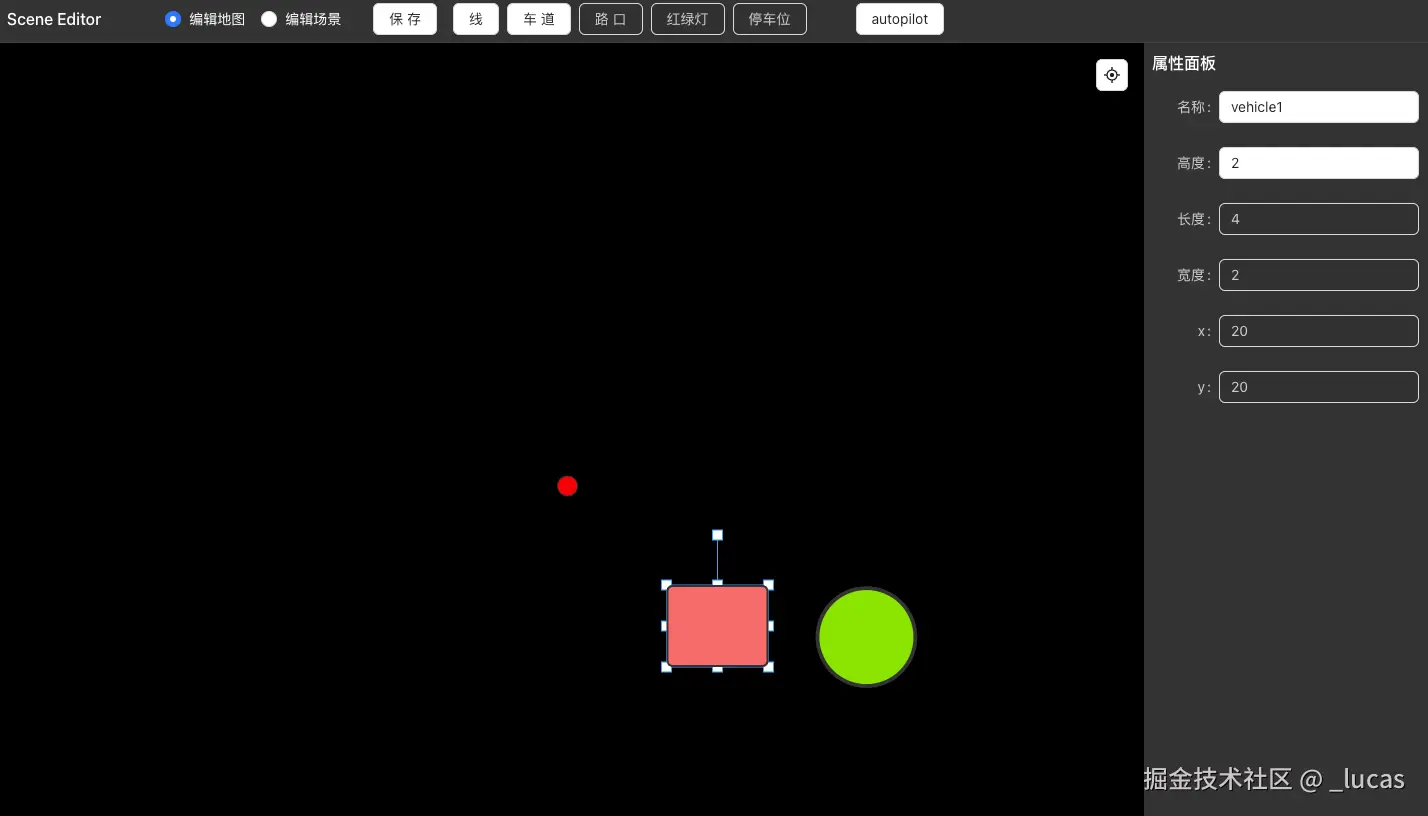
暂时先只做一个地图和一个场景,后面再扩展下多对多的情况
数据管理
通过 mobx 和 mobx-react-lite 来管理编辑器的数据。新建变量的时候,很多情况下你只需要一个全局变量而不是响应式变量,所以还是建议在 makeObservable 指定变量是否可观察(而不是一味 makeAutoObservable 虽然用这个有点爽),另外可以善用下observable.shallow 做浅层的观察,毕竟复杂的大对象在生成响应式对象时还是有一定开销的
ts
// store/index.ts
import Konva from "konva";
import { makeObservable, observable, computed, action } from "mobx";
class EditorStore {
stage: IStage = {
ref: null, // 暂存konva画布实例
};
editMode = EditMode.Map; // 编辑模式,分为地图和场景编辑
isEdit = false; // 编辑锁
isDrawLine = false; // 画线锁
// 统一处理场景元素的绘制
drawCallForScene = (type: ESceneElement) => {
this.isEdit = true;
switch (type) {
case ESceneElement.Vehicle: {
break;
}
default: {
break;
}
}
this.isEdit = false;
};
// 统一处理地图元素的绘制
drawCallForMap = (type: EMapElement) => {
this.isEdit = true;
switch (type) {
case EMapElement.Line: {
this.isDrawLine = true;
break;
}
default: {
break;
}
}
this.isEdit = false;
};
// 在初始化画布时执行,挂载画布事件
initStage = () => {
const stage = this.stage.ref!;
const layer = stage.getLayers()[0];
// ...
};
// 地图
mapList = [];
currentMap = "";
// 场景
sceneList = [];
currentScene = "";
// 元素
selectedElement = null;
// 当前选中的元素的属性,基础属性包括位置、颜色、旋转、大小、名称等
selectedElementProps = null;
constructor() {
makeObservable(this, {
stage: observable.shallow,
editMode: observable,
// ...文章代码可能不全,感兴趣自行查阅github源码
});
}
}初始化页面
新建一个 react 路由页面,初始化画布,监听画布事件比如点击、鼠标事件等,并自适应容器宽高
tsx
// scene-editor/index.tsx
const SceneEditor = observer(() => {
const { stage } = editorStore;
const containerRef = useRef<HTMLDivElement>(null);
const [shapes, setShapes] = useState<Konva.ShapeConfig[]>([]);
const [selectedId, setSelectedId] = useState<string>();
// 初始化画布
useEffect(() => {
if (containerRef.current) {
const container = containerRef.current;
stage.ref = new Konva.Stage({
container: containerRef.current,
width: container.clientWidth,
height: container.clientHeight,
draggable: true,
});
// 初始化图层
const layer = new Konva.Layer();
stage.ref.add(layer);
const resizeStage = () => {
stage.ref!.width(container.clientWidth);
stage.ref!.height(container.clientHeight);
// 批量绘制(放到同一帧绘制)
stage.ref!.batchDraw();
};
editorStore.initStage();
// 监听窗口变化
window.addEventListener("resize", resizeStage);
// 监听缩放
stage.ref.on("wheel", (e) => {
e.evt.preventDefault();
handleWheel(e.evt);
});
return () => {
stage.ref?.destroy();
window.removeEventListener("resize", resizeStage);
};
}
}, []);
return (
<div className="scene-editor">
{/* 顶部状态栏 */}
<Header />
<div ref={containerRef} style={{ width: "100%", height: "100%" }} />
{/* 侧边栏 */}
<RightSider />
</div>
);
});代码可能不全,可以查阅 github 源码
自车
自车默认位于原点位置,这里先简单用一个绿色矩形框来替代,在初始化的时候就自动添加到场景中。并且这里要先加一个元素控制器 Konva.Transformer,便于调整矩形框的大小和旋转角度
ts
// store/index.ts
// ...
initStage = () => {
// ...
// 初始化控制器
this.transformer = new Konva.Transformer({
// 启用旋转
rotateEnabled: true,
// 设置旋转吸附角度
rotationSnaps: [0, 90, 180, 270],
});
layer.add(this.transformer);
// ...然后监听点击事件,在点击到具体shape的时候动态加上控制器
stage.on("click", (e) => {
if (e.target === stage) {
this.transformer!.nodes([]);
} else {
const target = e.target as Konva.Shape;
// 这里其实可以做下限制,有些元素可能是不允许编辑的
// 比如地图元素在场景编辑模式下是不可编辑的
// if (target !== this.currentLine) {
this.transformer!.nodes([target]);
this.selectedElement = target;
// }
}
});
};自车相关的代码如下:
ts
// store/index.ts
// ...
initStage = () => {
//...
// 绘制自车
const autoCar = createRect({
fill: "green",
x: 0,
y: 0,
width: 30,
height: 20,
strokeWidth: 1,
});
layer.add(autoCar);
};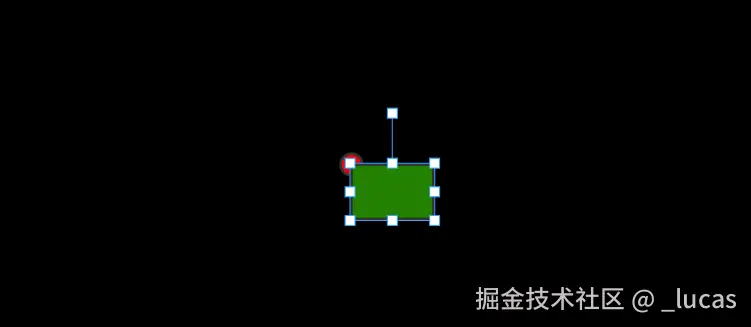
基础图形封装
其实 konva 本身已经封装了现成的图形绘制函数,这里是二次封装简化下代码量,基类代码如下:
ts
import Konva from "konva";
type ShapeType = "rect" | "circle" | "line" | "polygon" | "triangle";
export function createRect(config: Konva.RectConfig) {
return createShape("rect", {
width: 100,
height: 80,
...config,
});
}
export function createCircle(config: Konva.CircleConfig) {
return createShape("circle", {
radius: config?.radius || 50,
...config,
});
}
export function createTriangle(config: Konva.ShapeConfig) {
return createShape("triangle", {
offset: { x: 0, y: -15 }, // 居中调整
...config,
});
}
/**
* 图形基类
*/
export function createShape(type: ShapeType, config: any) {
const defaults = {
x: 0,
y: 0,
fill: Konva.Util.getRandomColor(),
draggable: true,
stroke: "#333",
strokeWidth: 2,
};
const shapeConfig = { ...defaults, ...config };
let shape: Konva.Shape;
switch (type) {
case "rect":
shape = new Konva.Rect(shapeConfig);
break;
case "circle":
shape = new Konva.Circle({
radius: 50,
...shapeConfig,
});
break;
case "line":
shape = new Konva.Line({
points: [0, 0, 100, 100], // 默认对角线
lineCap: "round",
...shapeConfig,
});
break;
case "polygon":
shape = new Konva.RegularPolygon({
sides: 5, // 默认五边形
radius: 60,
...shapeConfig,
});
break;
case "triangle":
shape = new Konva.Shape({
sceneFunc: function (context: Konva.Context, shape: Konva.Shape) {
context.beginPath();
context.moveTo(0, -30);
context.lineTo(30, 30);
context.lineTo(-30, 30);
context.closePath();
context.fillStrokeShape(shape);
},
...shapeConfig,
});
break;
}
shape!.on("click", () => console.log(`${type} clicked`));
shape!.on("dragend", () => console.log(`${type} moved`));
return shape!;
}交互实现
整体交互是先在场景编辑器编辑地图和交通场景,通过 localStorage 保存数据,然后通过指定按钮快速跳转到 autopilot 3d 页面查看仿真效果,可以翻到最后先看下录屏效果
地图交互
地图拖动。配置支持 draggable
ts
new Konva.Stage({
container: containerRef.current,
width: container.clientWidth,
height: container.clientHeight,
draggable: true,
});地图缩放。下面以鼠标滚轮缩放为例,基于鼠标位置做画布的缩放
ts
// scene-editor/index.tsx
// 监听鼠标滚轮事件
const MIN_SCALE = 0.5; // 最小缩放比例
const MAX_SCALE = 3; // 最大缩放比例
const handleWheel = (e: any) => {
const stageRef = stage.ref!;
const step = 1.1;
const oldScale = stageRef.scaleX();
const pointer = stageRef.getPointerPosition()!;
let newScale = e.deltaY < 0 ? oldScale * step : oldScale / step;
// 有最大和最小范围限制
newScale = Math.min(Math.max(newScale, MIN_SCALE), MAX_SCALE);
const mousePointTo = {
x: (pointer.x - stageRef.x()) / oldScale,
y: (pointer.y - stageRef.y()) / oldScale,
};
stageRef.scale({ x: newScale, y: newScale });
const newPos = {
x: pointer.x - mousePointTo.x * newScale,
y: pointer.y - mousePointTo.y * newScale,
};
stageRef.position(newPos);
stageRef.batchDraw();
};
// ...一键返回原点。可以在左上角加个悬浮按钮居中画布原点
ts
// store/index.ts
focusOrigin = () => {
if (this.stage.ref) {
// 清除拖拽产生的位移偏差
this.stage.ref.x(0);
this.stage.ref.y(0);
const centerX = -this.stage.ref.width() / 2;
const centerY = -this.stage.ref.height() / 2;
this.stage.ref.offset({ x: centerX, y: centerY });
}
};线段绘制
- 支持绘制直线和虚线
- 编辑过程加绘制锁,按 Q 键(Quit)退出线段绘制
这里需要在 initStage 监听鼠标点击和移动事件,具体看代码注释清晰点:
ts
// store/index.ts
// 暂存的线段对象,用于绘制多段直线
// ...
isDrawLine = false;
currentLine: Konva.Line | null = null;
// 点击顶部操作栏的线段按钮,会加编辑锁,便于多段线段的绘制
drawCallForMap = (type: EMapElement) => {
this.isEdit = true;
switch (type) {
case EMapElement.Line: {
this.isDrawLine = true;
break;
}
default: {
break;
}
}
this.isEdit = false;
};
// 在初始化画布时执行,挂载画布事件
initStage = () => {
const stage = this.stage.ref!;
const layer = stage.getLayers()[0];
// 点击时新建线段
stage.on("mousedown", () => {
if (this.isDrawLine) {
const pos = stage.getPointerPosition()!;
this.currentLine = new Konva.Line({
points: [pos.x, pos.y],
fill: "yellow",
stroke: "yellow",
strokeWidth: 2,
});
layer.add(this.currentLine);
}
});
// 移动鼠标可以选择下一段线段的落点
// TODO 这里其实可以做下节流
stage.on("mousemove", () => {
if (this.currentLine && this.isDrawLine) {
const pos = stage.getPointerPosition()!;
let newPoints = [];
if (this.currentLine.points().length > 2) {
newPoints = this.currentLine
.points()
.slice(0, -2)
.concat([pos.x, pos.y]);
} else {
newPoints = this.currentLine.points().concat([pos.x, pos.y]);
}
this.currentLine.points(newPoints);
layer.batchDraw();
}
});
// 监听键盘事件,这里设定在点击ESC键时结束线段的绘制
const onKeydown = (e: any) => {
if (e.key === "q") {
if (this.isDrawLine && this.currentLine) {
const newPoints = this.currentLine.points().slice(0, -2);
this.currentLine.points(newPoints);
layer.batchDraw();
this.isDrawLine = false;
this.currentLine = null;
}
}
};
window.addEventListener("keydown", onKeydown);
};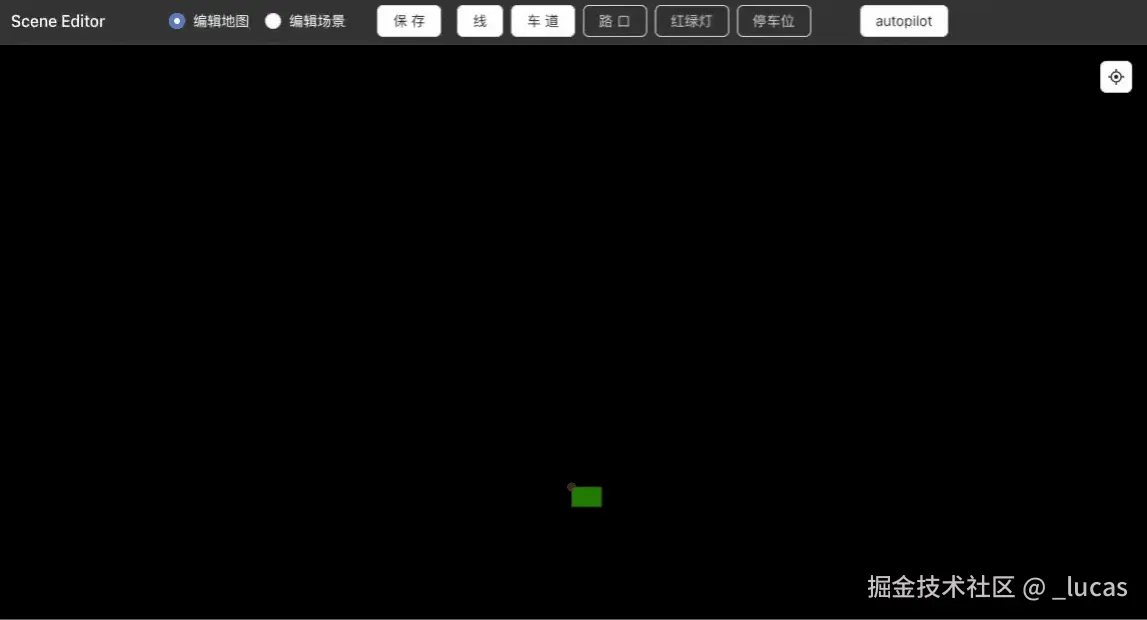
车道绘制
这里设计为三段式编辑,第一二次点击确定车道宽度,第三次点击确定长度,并且结束车道绘制。在第三次点击前有一个框体的高亮效果辅助定位范围
ts
// store/index.ts
isDrawMapElement: EMapElement | null = null;
// 车道辅助绘制,计算当前点击的次数
drawLaneCount = 0;
// 当前车道,多边形对象
currentLane: Konva.Shape | null = null;
stage.on("mousedown", () => {
// ...
if (this.isDrawMapElement === EMapElement.Lane) {
// 第一次点击,先绘制宽度线
if (this.drawLaneCount === 0) {
this.currentLine = new Konva.Line({
points: [pointX, pointY],
fill: "yellow",
stroke: "yellow",
strokeWidth: 2,
});
layer.add(this.currentLine);
// 第二次点击,确定宽度
} else if (this.drawLaneCount === 1) {
this.currentLine!.points().push(pointX, pointY);
// 第三次点击,确定长度
} else if (this.drawLaneCount === 2) {
this.currentLane?.destroy();
const points = [
this.currentLine!.points()[0],
this.currentLine!.points()[1],
this.currentLine!.points()[2],
this.currentLine!.points()[3],
pointX,
pointY,
pointX -
(this.currentLine!.points()[2] - this.currentLine!.points()[0]),
pointY -
(this.currentLine!.points()[3] - this.currentLine!.points()[1]),
];
this.currentLane = new Konva.Shape({
// 顶点坐标数组
points,
fill: "yellow",
stroke: "green",
opacity: 0.2,
strokeWidth: 2,
sceneFunc: function (ctx, shape) {
const points = shape.getAttr("points");
ctx.beginPath();
ctx.moveTo(points[0], points[1]);
for (let i = 2; i < points.length; i += 2) {
ctx.lineTo(points[i], points[i + 1]);
}
ctx.closePath();
ctx.fillStrokeShape(shape);
},
});
layer.add(this.currentLane);
this.drawDone(EMapElement.Lane);
}
this.drawLaneCount++;
}
})
stage.on("mousemove", () => {
// ...
if (this.currentLine && this.isDrawMapElement === EMapElement.Lane) {
const pos = stage.getPointerPosition()!;
const pointX = stage.offset().x + pos.x;
const pointY = stage.offset().y + pos.y;
let newPoints = [];
if (this.drawLaneCount === 1) {
if (this.currentLine.points().length > 2) {
newPoints = this.currentLine
.points()
.slice(0, -2)
.concat([pointX, pointY]);
} else {
newPoints = this.currentLine.points().concat([pointX, pointY]);
}
this.currentLine.points(newPoints);
layer.batchDraw();
} else if (this.drawLaneCount === 2) {
this.currentLane?.destroy();
// NOTE 注意按逆时针排,和threejs自定义多边形点集一致
const points = [
this.currentLine!.points()[0],
this.currentLine!.points()[1],
this.currentLine!.points()[2],
this.currentLine!.points()[3],
pointX,
pointY,
pointX -
(this.currentLine!.points()[2] - this.currentLine!.points()[0]),
pointY -
(this.currentLine!.points()[3] - this.currentLine!.points()[1]),
];
this.currentLane = new Konva.Shape({
points,
fill: "yellow",
stroke: "green",
opacity: 0.2,
strokeWidth: 2,
sceneFunc: function (ctx, shape) {
const points = shape.getAttr("points");
ctx.beginPath();
ctx.moveTo(points[0], points[1]);
for (let i = 2; i < points.length; i += 2) {
ctx.lineTo(points[i], points[i + 1]);
}
ctx.closePath();
ctx.fillStrokeShape(shape);
},
});
layer.add(this.currentLane);
}
}
})
// 在这里统一处理绘制结束的逻辑
drawDone = (type: EMapElement | ESceneElement) => {
// ...
if (type === EMapElement.Lane) {
const contour = _.chunk(this.currentLane?.getAttr("points"), 2).map(
(item) =>
({
x: item[0],
y: item[1],
z: 0,
} as { x: number; y: number; z: number })
);
const data: IFreespace = {
id: "freespace" + this.mapElements.lanes.length,
contour,
};
this.mapElements.lanes.push(data);
this.currentLine?.destroy();
this.currentLane = null;
this.currentLine = null;
this.drawLaneCount = 0;
}
}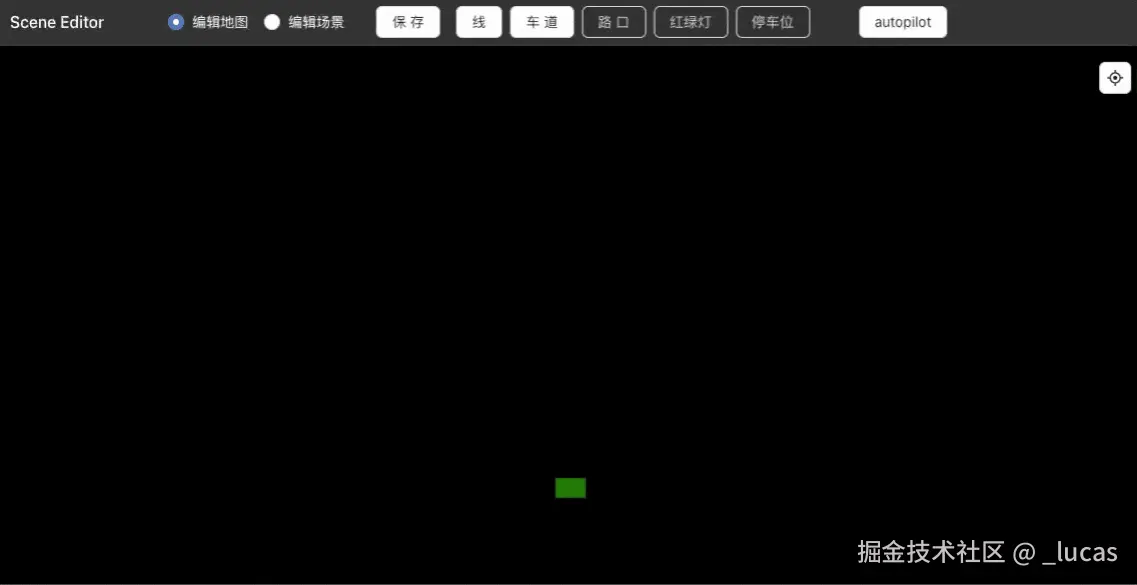
场景编辑
先支持他车的编辑,以矩形框替代,可以设置高度,看看这个交互是咋样的:
- 点击他车按钮
- 点击画布任意处新增他车矩形框
- 添加他车矩形框,矩形框支持旋转、改变大小和拖动
- 处于选中状态时,右侧表单自动回填属性,包括名称、宽高、位置等,可以修改,保存场景时会以最新的属性为准
添加代码参考:
ts
// store/index.ts
// 当前正在绘制的场景元素
isDrawSceneElement: ESceneElement | null = null;
drawCallForScene = (type: ESceneElement) => {
this.isEdit = true;
switch (type) {
case ESceneElement.Vehicle: {
this.isDrawSceneElement = ESceneElement.Vehicle;
break;
}
default: {
break;
}
}
this.isEdit = false;
};
// ...
stage.on("click", (e) => {
if (e.target === stage) {
// ...
if (this.isDrawSceneElement === ESceneElement.Vehicle) {
const pos = stage.getPointerPosition()!;
const pointX = stage.offset().x + pos.x;
const pointY = stage.offset().y + pos.y;
const vehicle = createRect({
fill: "blue",
x: pointX,
y: pointY,
width: 40,
height: 30,
strokeWidth: 1,
// 居中
offsetX: 15,
offsetY: 10,
});
layer.add(vehicle);
layer.batchDraw();
// 自动选中
this.transformer!.nodes([vehicle]);
this.isDrawSceneElement = null;
}
} else {
// ...
}
});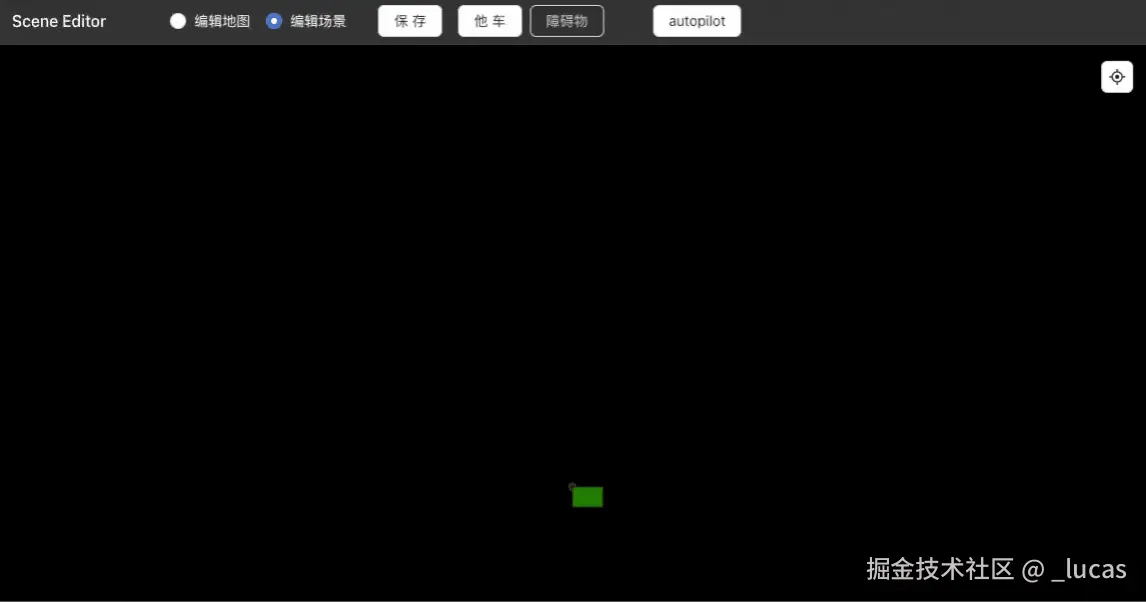
自车或他车路线编辑
这里先做成匀速的场景,后面可以扩展到更多行驶场景,当然这需要一定的算法 ~ 路线绘制的话,可以复用上面的画线逻辑
选中目标后,路线编辑按钮可点击,这个时候可以编辑对应的路线,路线起点是选中目标的原点,不过这里要注意加一下和他车或自车的关联。另外选中状态下,可以在右侧表单中设置速度
下面是绘制自车路线的示例,环境车其实也类似,注意和路线做下关联就行了:
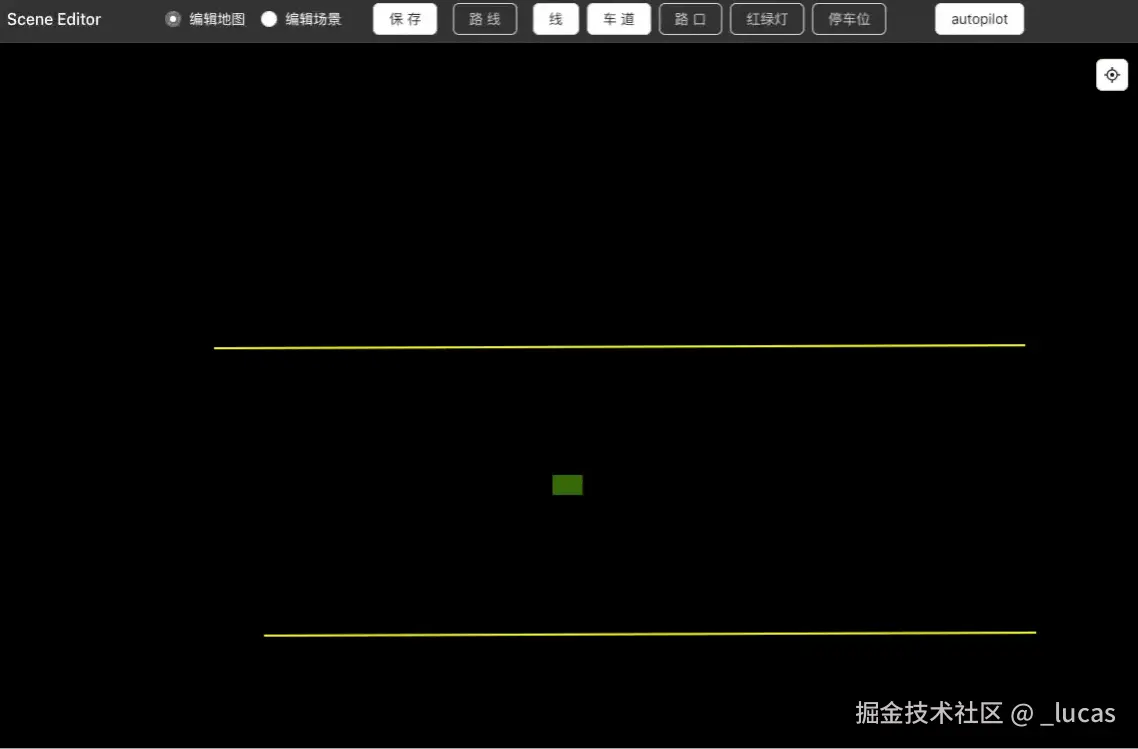
和 autopilot 交互
顶部右侧有一个按钮,可以点击后跳转到 autopilot 页面,快速预览 3d 效果,先简单从 localStorage 读取数据。数据结构方面,2d 元素这里其实和 3d 元素只有一个 z 轴的区别,其他结构其实差不多,场景元素主要都是点集,这里注意下坐标轴方向(编辑器现在 y 轴是反向...有点别扭其实)
保存场景数据
需要遍历场景元素,转换成 autopilot 能接受的接口数据(json),场景数据参考下面的类型定义:
ts
// 编辑器输出的场景数据
export interface ISceneData {
autoCar: {
pos: number[];
rotation: number;
path: number[][];
};
map: IMapElements;
scene: ISceneElements;
}
// 自车属性
export interface IAutoCar {
ref: Konva.Rect | null;
config: {
x: number;
y: number;
rotation: number;
};
path: number[][];
speed: number;
}
// 地图元素集合
export interface IMapElements {
lines: ILine[];
lanes: IFreespace[];
}
// 场景元素集合
export interface ISceneElements {
vehicles: ICube[];
obstacles: ICube[];
}看下编辑器和 autopilot 初步联动的静态效果:
编辑器:

autopilot 俯视:
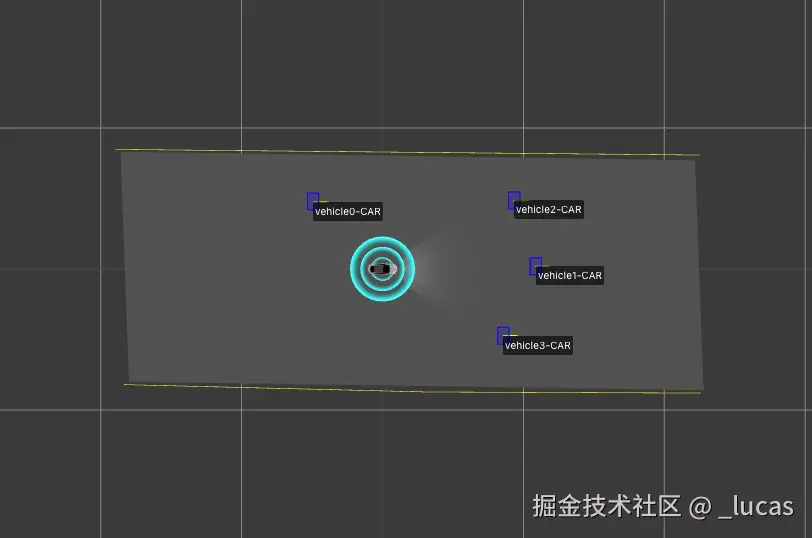
再把速度加上,这里就假定车子是匀速,然后车子朝向固定为前后俩点的方向,下面是自车速度的实现示例,当然实际业务研发中,路线主要是上游算法或地图给的点集数据,这里纯粹做个演示,然后他车的匀速行驶也类似:
ts
// renderer/index.ts
// 模拟匀速行驶
// ...
if (path.length > 0) {
// 生成平滑曲线
const curve = new THREE.CatmullRomCurve3(
path.map((p) => new THREE.Vector3(p[0] / 100, -p[1] / 100, 0)),
false
);
const totalLength = curve.getLength();
// 总时长 ms
this.totalDuration = (totalLength / speed) * 1000;
// 拆分为5000个点
this.pathPoints = curve.getPoints(5000);
}
// ...
totalDuration = 0;
pathPoints: any[] = [];
startTime = 0;
currentIndex = 0;
mockAutoDrive() {
if (!this.startTime) this.startTime = performance.now();
const elapsed = performance.now() - this.startTime;
const progress = Math.min(elapsed / this.totalDuration, 1);
this.currentIndex = Math.floor(progress * (this.pathPoints.length - 1));
if (this.currentIndex < this.pathPoints.length - 1) {
const currentPoint = this.pathPoints[this.currentIndex];
const nextPoint = this.pathPoints[this.currentIndex + 1];
// 动态计算自车位置
this.egoCar!.group.position.set(currentPoint.x, -currentPoint.y, 0);
// 自车朝向
const dx = nextPoint.x - currentPoint.x;
const dy = nextPoint.y - currentPoint.y;
this.egoCar!.group.rotation.z = -Math.PI / 2 + Math.atan2(dx, dy);
}
}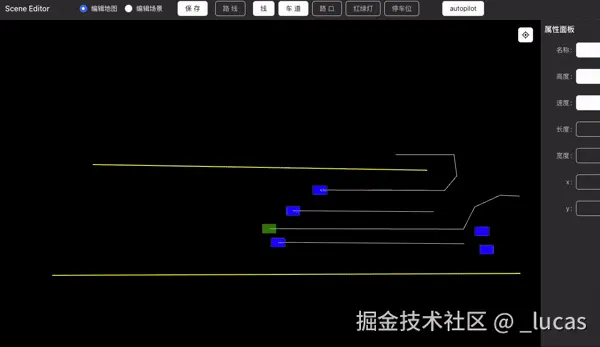
最后
现在元素还比较少,功能相对简单,后面复杂一点还要碰一碰算法和性能问题
anyway,麻雀虽小,bug 超多<抱拳>,keep learning and respect